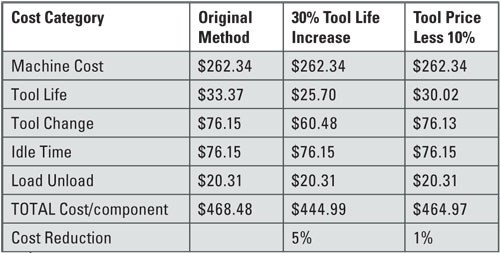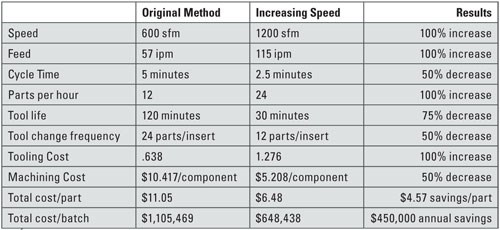Sacrificing Tool Life for Increased Productivity
To compete overseas by improving productivity, moldmakers need to focus on lowering the total machining cost per component.
Share
Read Next
Given the growth of overseas competition, moldmakers have become accustomed to, although not comfortable with, having to compete with low-cost labor countries such as China. In order to survive, many companies turn to cost-cutting measures, looking for cutting tools that offer the longest tool life for a value price. On the surface, maximum tool life appears to be the solution for achieving increased productivity and immediate cost-savings. Reducing the number of tool changes allows for minimal disruption to production, which provides better process stabilization, less downtime and consistent delivery of parts out the door.
However, if you take a closer look, taking this path will most likely not lower costs enough to win work back from overseas competition. The focus really has to be placed upon the idea of lowering the total machining cost per component, which involves other factors besides tool life.
Chart 1 represents the economics of metal cutting. In America, almost three quarters of manufacturing is invested in fixed costs, with labor fees overwhelmingly representing the lion’s share. Chart 1 shows how a typical breakout of production costs per component produced tends to fall.
Within the costs that can be affected by process—the variable costs—cutting tools represent a mere 3 percent of total cost. This means that even a significant reduction in tool cost or increase in tool life will still only result in a minimal decrease in total cost per component.
When you look at the variables that can be influenced, it becomes obvious that a smarter way to cut costs would be through productivity improvements in the machining process. Reducing your machining time—the largest share of the variable costs—through higher speeds and feeds means that you adversely affect tool life, which tends to go against the grain of conventional wisdom.
What you should be striving for is better utilization and application of the tooling so you can influence the process by increasing productivity. This begins with the right machine, properly applied tooling, setup and adequate fixturing for the application, and ends by directly reducing the cycle time to produce a greater number of parts over the same amount of time. The result is a reduction in fixed costs as they are now shared across a greater number of parts, in addition to opening up the shop for more capacity. The machine, labor and overhead costs previously incurred by this job now decrease through improved productivity. If you define productivity as more parts out the door, then you may want to sacrifice tool life by turning up the feed and speed rates in your process. Let’s look at some examples in Charts 2 and 3.
As you can see in Chart 2, making gains in either tool life or through reduced tooling costs have a minimal effect on the cost reduction. Instead, let’s look at how a significant increase in productivity (parts produced) can have a substantial influence on overall cost. A recent customer application involved an average hourly machining rate of $125/hour and the number of components produced per year was 100,000.
Chart 3 illustrates that despite an increase in tooling cost, overall cost per batch resulted in a 42-percent reduction in annual machining costs! This 50-percent increase in productivity may seem an extreme example, but even a 20-percent productivity increase will significantly reduce total cost per part.
So, when should you consider pushing the speeds and feeds knowing you may lose tool life? In reality, every job is a candidate for this methodology. If you are nervous about pushing the machining parameters as published in the literature, then you need to rely upon cutting tool experts to analyze the application.
Consider a service such as Productivity Cost Analysis (PCA)1 that runs data that will reveal how much you can gain through pushing speeds and feeds. In the end, the only way to compete with overseas labor fees is by achieving significant productivity gains through innovative applications of tooling and processes that will lower overall machining costs.
Read Next
How to Use Continuing Education to Remain Competitive in Moldmaking
Continued training helps moldmakers make tooling decisions and properly use the latest cutting tool to efficiently machine high-quality molds.
Read MoreHow to Use Strategic Planning Tools, Data to Manage the Human Side of Business
Q&A with Marion Wells, MMT EAB member and founder of Human Asset Management.
Read MoreAre You a Moldmaker Considering 3D Printing? Consider the 3D Printing Workshop at NPE2024
Presentations will cover 3D printing for mold tooling, material innovation, product development, bridge production and full-scale, high-volume additive manufacturing.
Read More





















